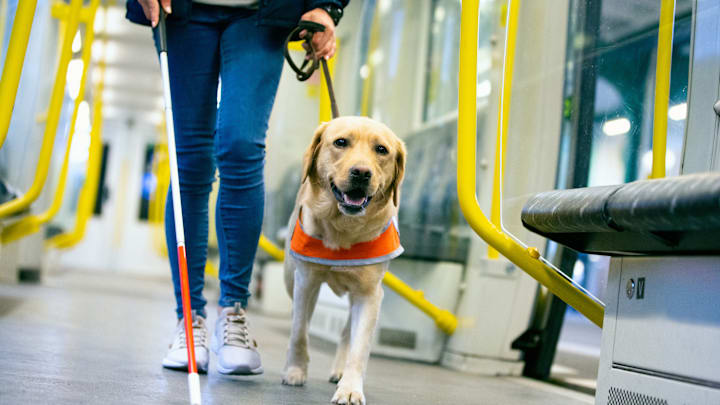All dogs carry the potential to be good dogs, but some actually provide a service that goes well beyond companionship. Trained service animals can help people with disabilities navigate public places, offer support for anxiety, or even warn owners of imminent health issues like seizures. Roughly 500,000 Americans use service dogs for these and other reasons.
To others, these dogs can be awfully tempting to pet: They’re calm, collected, and smart. But there are a few good reasons why you should never give them the same kind of attention you would a non-working animal.
The primary reason you should keep clear is that a service dog—one trained for physical assistance tasks and often identified by harness, vest, or other signage—is effectively on duty. And when the animal is doing its job by acting as their owner’s eyes or ears, distracting them could be potentially dangerous. According to Rivi Israel, a guide dog program manager who spoke with Reader’s Digest, even making eye contact with a service animal is unwise. They need to have their full attention directed toward their owner’s needs. Offering a treat or encouraging one to come your way means it’s no longer focused.
"A lot of people have balance issues and if the dog moves in one direction because it’s accepting a greeting from a stranger and the handler isn’t fully aware of it, it can throw the person off balance and cause them to fall," CJ Betancourt, MD, the executive director of the Foundation for Service Dog Support, told the Digest.
One should never assume a service dog is on a break, either. Regardless of whether a dog is walking, sitting, or even sleeping, it’s best to consider it off-limits.
Unfortunately, not everyone respects those boundaries. Speaking with The San Diego Union-Tribune in 2021, several service animal owners said that people persist in approaching their dogs despite the dog’s apparel advising them to keep clear. It’s particularly problematic when the owners are experiencing mental health issues: Interacting with strangers can be stressful.
Keep in mind that while many service dogs have harnesses or other telltale signs of their on-the-job activity, they’re not required to wear anything, and a dog that may appear to be strictly a pet could still be working.
Guide dogs are a little different than service dogs. That term is used specifically for dogs trained to assist the vision-impaired. But the rule of thumb (or paw) remains the same: It’s best not to disturb them.
[h/t Reader’s Digest]
